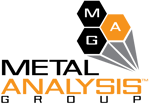EXPERT-APPROVED: LIBS ALLOY
Expert-Approved LIBS Analyzers for Scrap Metal from Metal Analysis Group
In the realm of metal recycling, rapid and accurate identification of various metal types is paramount for efficient processing. Laser-Induced Breakdown Spectroscopy (LIBS) stands out as a technology capable of swiftly identifying metals while conducting simultaneous multi-element analyses. Unlike X-Ray Fluorescence (XRF), LIBS scanners do not emit radiation, eliminating the need for extra Personal Protective Equipment (PPE) or licensing and mitigating concerns of exposure.
Traditionally, LIBS excelled in analyzing light metals like aluminum, offering superior performance compared to XRF scanners. However, modern XRF scanners have narrowed this performance gap. Despite this, LIBS maintains its edge in sorting aluminum, known for its cost-efficiency in processing for re-use.
John I.H. Patterson, PhD., an expert in metal analysis, noted that while LIBS excels in rapid identification, XRF remains preferable for applications where accuracy and precision are critical, particularly for heavy metals, high-temperature alloys, and stainless steel sorting.
To address the limitations of traditional sorting techniques, researchers have turned to chemistry-based methods like LIBS. LIBS has undergone significant development, enabling precise differentiation of alloying elements crucial for recycling processors aiming to shorten furnace turns and create a variety of alloy classes from scrap.
Austin AI’s patented LIBS sensor-based sorting system stands as a testament to LIBS's effectiveness, boasting satisfied clientele and successful outcomes. Moreover, researchers at the Gwangju Institute of Science and Technology (GIST) have introduced a groundbreaking model combining LIBS with machine learning for scrap metal identification.
Their model, named Aug2Tran, augments the standard reference material (SRM) dataset and employs transfer learning to build a robust real-time classification model. By synthesizing spectra through attenuation of dominant peaks and using a generative adversarial network, the model overcomes challenges posed by limited training sets and differences in experimental configurations.
The Aug2Tran model demonstrates remarkable accuracy in identifying scrap metal types, even amidst varying surface contaminations and compositions. Evaluations revealed an average classification accuracy of 98.25%, rivaling conventional schemes with separately trained models.
LIBS, with its ability to swiftly identify unknown samples without extensive sample preparation, coupled with machine learning advancements, holds promise for industrial applications such as scrap metal recycling. The Aug2Tran model not only enhances classification accuracy but also contributes to the efficient and sustainable utilization of resources.
In summary, the fusion of LIBS technology and machine learning represents a significant advancement in metal sorting, paving the way for more efficient and environmentally friendly recycling practices.
